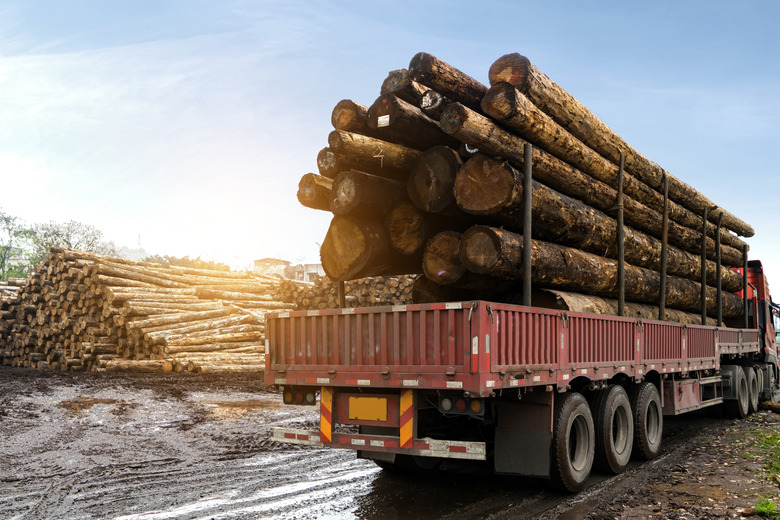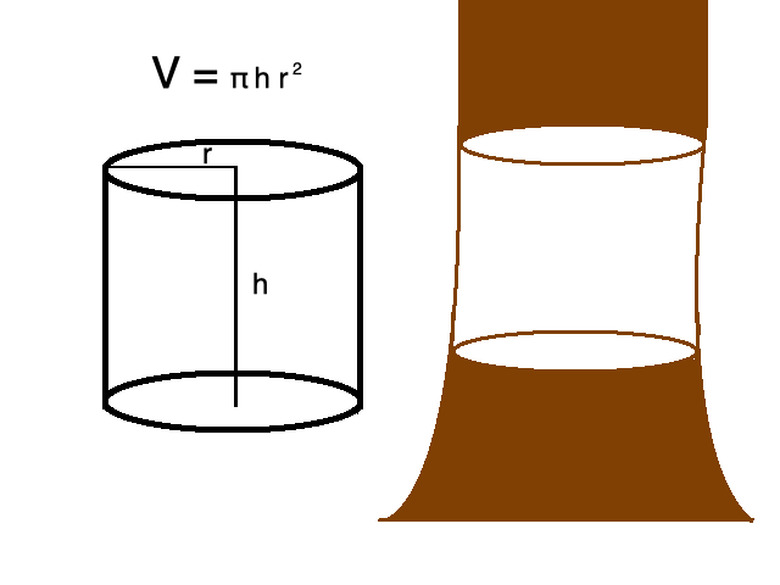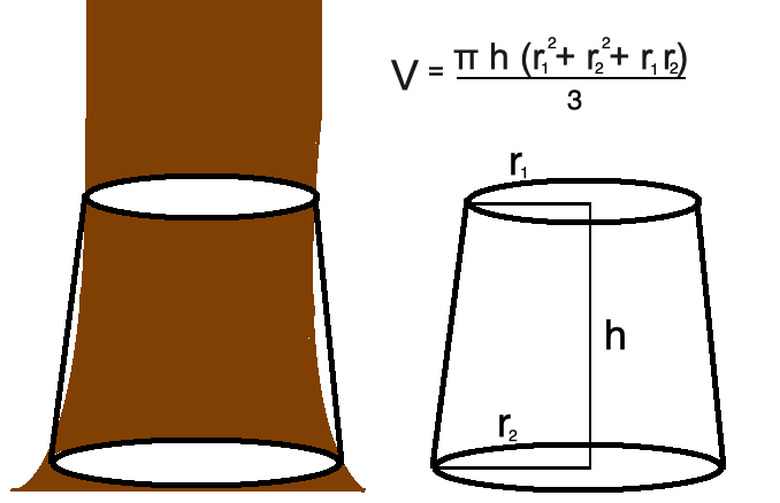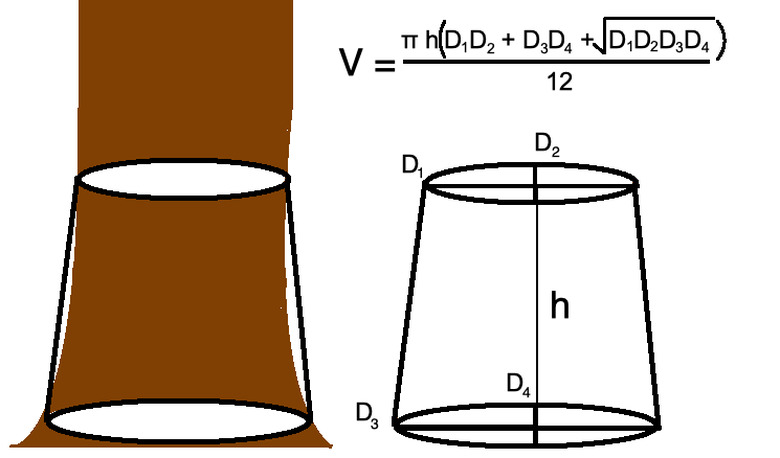How To Calculate The Cubic Feet Of A Log
Volume of Wood
Volume of Wood
The cubic feet, or volume, of a cylindrical log is given by the volume of a cylinder V=πhr2. A log with radius of 2 feet and height of 10 feet would have a volume of about 125.66 cubic feet (or ft3). The volume can also be thought of as the area of the base times height with the base area being the area of a circle (A=πr2).
This formula assumes logs are perfect or near-perfect cylinders. Similarly, for cubic meters of volume, the radius and height must be in meters. Height must be measured from the center of one basis to center of the other.
When converting between different volume measurements, make sure to multiply the value of the volume by how many units are needed to convert between the different measurements while accounting for the dimensions of the units.
For example, if you had 100 cubic feet that you wanted to convert to inches, you wouldn't just multiple 100 by 12. You would multiply 100 by 123 to account for the fact that volume is three-dimensional to end up with 172,800 cubic inches.
TL;DR (Too Long; Didn't Read)
A cylindrical log's volume in cubic feet equals pi times the height times its radius squared (V=πhr2) in which radius and height are also given in feet. For more realistic logs, the formula is more complicated.
Timber Measurement Calculator
Timber Measurement Calculator
When a log is truncated from a tree, it generally retains some of the shape of the tree's trunk. The trunk volume depends upon the radii of the top and bottom segments and the height between these two circular areas.
If you imagine the cubic feet of a log this way, the formula is slightly more complicated. For these limbs of the tree, the cubic feet volume is
\(V=\pi h \frac{r_1^2+r_2^2+r_1r_2}{3}\)
in which _r1_ and _r2_ are the radii of the two circular bases.
These more realistic segments can form the basis for calculating volume of trees. The limb length formula accounts for changes in diameter of a tree trunk. This shape is called a frustum, the portion of a cone or pyramid that remains when it is intercepted between two such planes.
You can imagine the top and bottom circular bases as two different planes that intercept a larger cone structure. It's important to note these cone-like estimates always overestimate how much volume a tree trunk or log actually is as they are greater than the trees themselves.
Timber Measurement Formula
Timber Measurement Formula
You can imagine an even more realistic log formed with elliptical, not circular, bases. In this case, each base can be described using two different diameters, one for the length and one for the width of the circle. This gives D1 and _D2_ for one ellipse and _D3_ and D4 for the other. The formula for volume of this elliptical trunk is
\(V=\pi h \frac{D_1D_2+D_3D_4+\sqrt{D_1D_2D_3D_4}}{12}\)
Refining formulas and methods takes more work, but gives more precise measurements.
References
- Native Tree Society: Tree Measuring Guidelines of the Eastern Native Tree Society
- Math Open Reference: Volume of a cylinder
- Extension: How to Measure Trees and Logs
- WunderWoods: Doyle Log Scale: How To Determine Board Feet In A Log
- Timbeter: How do you measure roundwood?
- Timberbuyer: What are Log Rules?
Board Feet of a Tree
You can visualize the board foot of a tree as a board of wood 12 inches by length and width and one inch thick, making it 144 cubic inches. The board foot content of a tree or group of lumber is used as a measurement of a tree's volume.
When woodland owners in the United States are buying and selling timber, they estimate these quantities of the volume using this value in measurements of volume. Simply divide the volume of a tree by the volume of a board foot to determine a tree's board foot-volume or board-foot content.
Because the ways trees are cut depends on many factors such as the dimensions of the log necessary and the proportion of the log's content lost as sawdust or other waste products, the board-foot content is often estimated.
The board-foot content also doesn't account for the quality of the wood itself so professionals working in the lumber industry need to be aware of what they are precisely measuring.
There are three commonly used scales when measuring board-foot tree volume, the Doyle, Scribner and the **International 1/4"** scales. These scales let you calculate the board feet of groups of logs when you know their diameter at breast height. They consist of a mix of "rule of thumb" measurements and precise calculations that are used for the purposes and principles of different companies.
Using the Scales
When you find a scale online in chart-form, to use the scale, measure in inches the average diameter of the small end of the log. You can estimate this value by examining the log. Then measure the length of the log in feet. Locate the row and column on the appropriate scale to determine the board footage for the log.
Perform this on each log while taking into account the quality of the logs, like how curved they are or the condition of the wood.
The Doyle scale is most commonly used scale in the Midwest. It lets the thickness of the woodcutting blade be 5/16 of an inch with 4 inches for the slabbing process. This does mean that the Doyle scale isn't exactly precise because it underestimates small logs and overestimates larger logs.
The Scribner scale involves drawing the cross-sections of 1-inch boards in circles to represent the end views of logs. It leaves a space of a 1/4 of an inch between the boards to account for the thickness of the woodcutting equipment. This also underestimates some logs, particularly long ones.
Finally, the International 1/4" rule lets you use a 1/4-inch thickness of the woodcutter with a taper length of 1/3 an inch per 4 feet of the log by length. You should also take into account the way the boards shrink and the slab thickness may vary. This rule is much more consistent and more effectiveness in comparing log volumes.
Round Wood Measurement Calculator
In addition to the cylindrical formulas and Doyle, Scribner and International 1/4" scales, there are other scales you can use for different purposes of measuring the volume of wood. These formula and scales are used by different industries for different regions and requirements by the woodworking businesses in those areas.
The JAS Scale, popular in Japan and other Eastern Asian countries, lets you calculate the volume _D2L/10000_ with D as the small end's diameter in centimeters and L and the length in meters for logs less than 6 meters long. This gives an accurate, straightforward calculation of volume.
The Roy Log rule, common in Quebec, Canada, is used to accurately measure 14-foot and 16-foot logs. It's calculated as board feet as _(D-1)2L/20_ for D, the scaling diameter in inches inside the bark on the smaller end of the log and L as the log's length in feet. Unfortunately this method overestimates log volumes for smaller logs.
In Ontario, Canada, mills use the Ontario Scaler's Rule to measure board feet as (0.55D² – 1.2D) * L/12 for a scaling diameter D measured the same way as the Roy Log Rule with L also as the log length in feet.
Cite This Article
MLA
Ather, S. Hussain. "How To Calculate The Cubic Feet Of A Log" sciencing.com, https://www.sciencing.com/calculate-cubic-feet-log-6527592/. 22 December 2020.
APA
Ather, S. Hussain. (2020, December 22). How To Calculate The Cubic Feet Of A Log. sciencing.com. Retrieved from https://www.sciencing.com/calculate-cubic-feet-log-6527592/
Chicago
Ather, S. Hussain. How To Calculate The Cubic Feet Of A Log last modified March 24, 2022. https://www.sciencing.com/calculate-cubic-feet-log-6527592/



